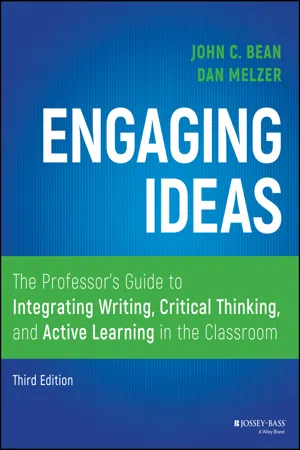
Engaging Ideas
The Professor's Guide to Integrating Writing, Critical Thinking, and Active Learning in the Classroom
- English
- ePUB (mobile friendly)
- Available on iOS & Android
Engaging Ideas
The Professor's Guide to Integrating Writing, Critical Thinking, and Active Learning in the Classroom
About this book
Use your course's big ideas to accelerate students' growth as writers and critical thinkers
The newly revised third edition of Engaging Ideas delivers a step-by-step guide for designing writing assignments and critical thinking activities that engage students with important subject-matter questions. This new edition of the celebrated book (now written by the co-author team of Bean and Melzer) uses leading and current research and theory to help you link active learning pedagogy to your courses' subject matter. You'll learn how to:
- Design formal and informal writing assignments that guide students toward thinking like experts in your discipline
- Use time-saving strategies for coaching the writing process and handling the paper load including alternatives to traditional grading such as portfolio assessment and contract grading
- Help students use self-assessment and peer response to improve their work
- Develop better ways than the traditional research paper to teach undergraduate reading and research
- Integrate social media, multimodal genres, and digital technology into the classroom to promote active learning
This book demonstrates how writing can easily be integrated with other critical thinking activities such as inquiry discussions, simulation games, classroom debates, and interactive lectures. The reward of this book is watching students come to class better prepared, more vested in the questions your course investigates, more apt to study purposefully, and more likely to submit high-quality work. Perfect for higher education faculty and curriculum designers across all disciplines, Engaging Ideas will also earn a place in the libraries of graduate students in higher education.
Frequently asked questions
- Essential is ideal for learners and professionals who enjoy exploring a wide range of subjects. Access the Essential Library with 800,000+ trusted titles and best-sellers across business, personal growth, and the humanities. Includes unlimited reading time and Standard Read Aloud voice.
- Complete: Perfect for advanced learners and researchers needing full, unrestricted access. Unlock 1.4M+ books across hundreds of subjects, including academic and specialized titles. The Complete Plan also includes advanced features like Premium Read Aloud and Research Assistant.
Please note we cannot support devices running on iOS 13 and Android 7 or earlier. Learn more about using the app.
Information
1
Using Writing to Promote Thinking : A Busy Professor's Guide to the Whole Book
The relationship between the amount of writing for a course and students' level of engagement—whether engagement is measured by time spent on the course, or the intellectual challenge it presents, or students' level of interest in it—is stronger than the relationship between students' engagement and any other course characteristic. (55)
Steps for Integrating Writing and Critical Thinking Activities into a Course
Step 1: Become Familiar with Some of the General Principles Linking Writing to Learning and Critical Thinking
Critical Thinking Rooted in Problems
Disciplinary versus Generic Domains for Critical Thinking
The Link between Writing and Critical Thinking
Step 2: Design Your Course with Critical Thinking Objectives in Mind
- Critical thinking is a learnable skill; the instructor and peers are resources in developing critical thinking skills.
- Problems, questions, or issues are the point of entry into the subject and a source of motivation for sustained inquiry.
- Successful courses balance challenges to think critically with support tailored to students' developmental needs.
- Courses are assignment centered rather than text and lecture centered. Goals, methods, and evaluation emphasize using content rather than simply acquiring it.
- Students are required to formulate and justify their ideas in writing or other appropriate modes.
- Students collaborate to learn and to stretch their thinking, for example, in pair problem solving and small‐group work.
- Several courses, particularly those that teach problem‐solving skills, nurture students' metacognitive abilities.
- The developmental needs of students are acknowledged and used as information in the design of the course. Teachers in these courses make standards explicit and then help students learn how to achieve them. (88–89)
Table of contents
- Cover
- Table of Contents
- Title Page
- Copyright
- Preface
- About the Authors
- 1 Using Writing to Promote Thinking
- PART ONE: Understanding Connections Between Thinking and Writing
- PART TWO: Designing Problem - Based Writing Assignments
- PART THREE: Coaching Students as Learners, Thinkers, and Writers
- PART FOUR: Responding to and Grading Student Writing
- References
- Index
- End User License Agreement